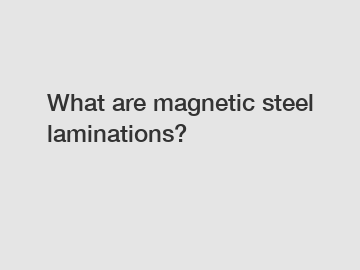What are magnetic steel laminations?
What are Magnetic Steel Laminations?
Magnetic steel laminations are an essential component in the construction of various electrical equipment and devices. These laminations are thin layers or sheets of specially processed electrical steel, typically made from materials like silicon steel or oriented electrical steel. They are designed to optimize the performance and efficiency of electrical, magnetic, and electromagnetic systems by reducing energy loss due to magnetic hysteresis and eddy currents.
Understanding Magnetic Steel Laminations.

Magnetic steel laminations are created by stacking multiple thin sheets or laminations of electrical steel together. These sheets are typically coated with an insulating material, such as varnish or oxide, to minimize electrical conductivity between adjacent laminations and prevent the formation of eddy currents. The individual laminations are then bonded or riveted together to form a solid, compact core structure.
The core structure of magnetic steel laminations is usually shaped in the form of a toroid, E, or I. The specific shape depends on the application and the desired magnetic properties. Toroidal cores are commonly used in transformers and inductors, while E and I shapes are frequently found in electric motors and generators.
Why Are Magnetic Steel Laminations Used?
Magnetic steel laminations are used in electrical equipment because they offer several advantages over solid core structures. Here are some key benefits:
1. Reduced Energy Loss: Magnetic steel laminations are designed to minimize energy loss due to magnetic hysteresis and eddy currents. By using laminated cores, the magnetic field can be efficiently generated and maintained, resulting in higher device efficiency and reduced power wastage.
2. Lower Operating Temperatures: The core structure of magnetic steel laminations allows for improved heat dissipation. This leads to lower operating temperatures of electrical equipment, which can increase their lifespan and prevent thermal damage.
3. Enhanced Magnetic Performance: The use of laminations enables more precise control of magnetic properties, such as permeability and saturation, by optimizing the grain orientation and reducing irregularities. This improves the overall magnetic performance of the equipment.
4. Noise Reduction: Magnetic steel laminations can help reduce vibration and noise levels caused by magnetic flux variations and core losses. This is especially important in applications like transformers, where noise reduction is crucial.
Magnetic Steel Lamination Applications.
Magnetic steel laminations find applications in a wide range of electrical and electronic devices. Some major applications include:
1. Transformers: Magnetic steel laminations are extensively used in power and distribution transformers to efficiently transfer electrical energy between different voltage levels.
2. Inductors and Chokes: These components use laminated magnetic cores to store and release energy in various electronic circuits, such as in power supplies and filters.
3. Electric Motors and Generators: Magnetic steel laminations form the core structure in electric motors and generators, enabling the conversion of electrical energy into mechanical energy or vice versa.
4. Magnetic Sensors: Certain types of magnetic sensors, such as Hall-effect sensors and magnetic encoders, rely on laminated cores to provide accurate and reliable measurement of magnetic fields.
Contact Us.
If you are looking for high-quality magnetic steel laminations for your electrical equipment needs, feel free to reach out to us. Our team of experts will be happy to assist you with your specific requirements and provide solutions tailored to your needs. Contact us now for more information and to discuss your project.
Contact us to discuss your requirements of Internal Threaded Pot Magnet Of Ndfeb, Neodymium Laminated Magnet for sale, Magnetic Steel Triangle Chamfer Manufacturer. Our experienced sales team can help you identify the options that best suit your needs.


